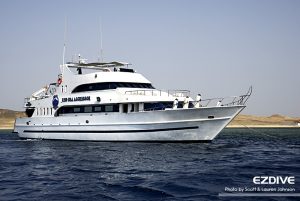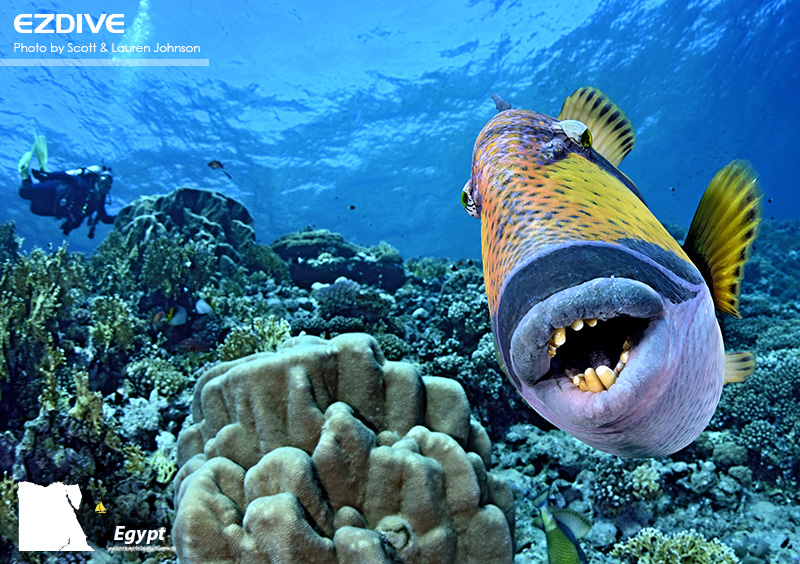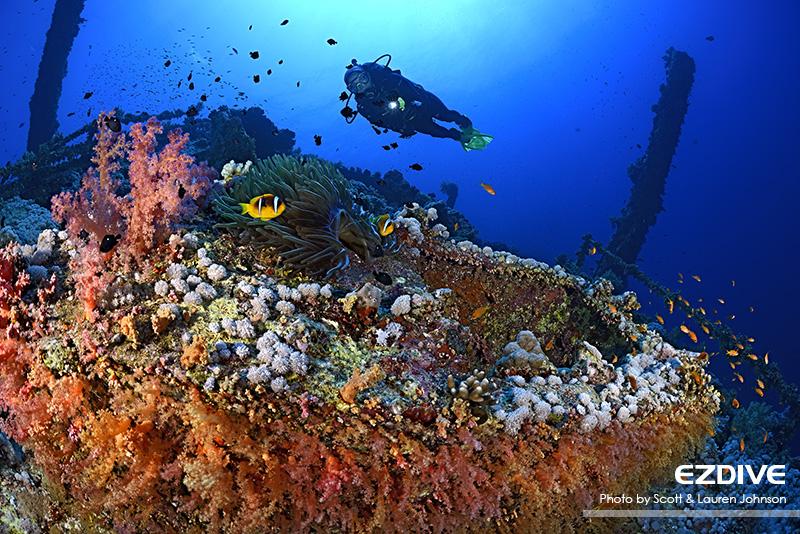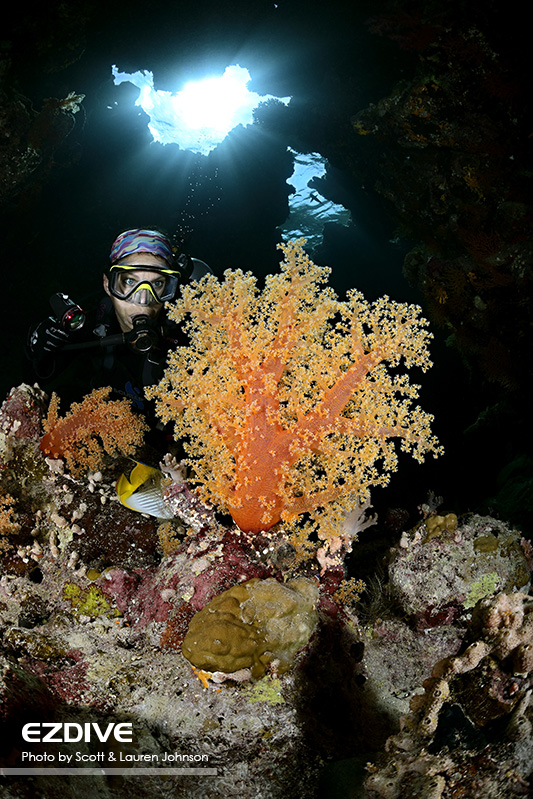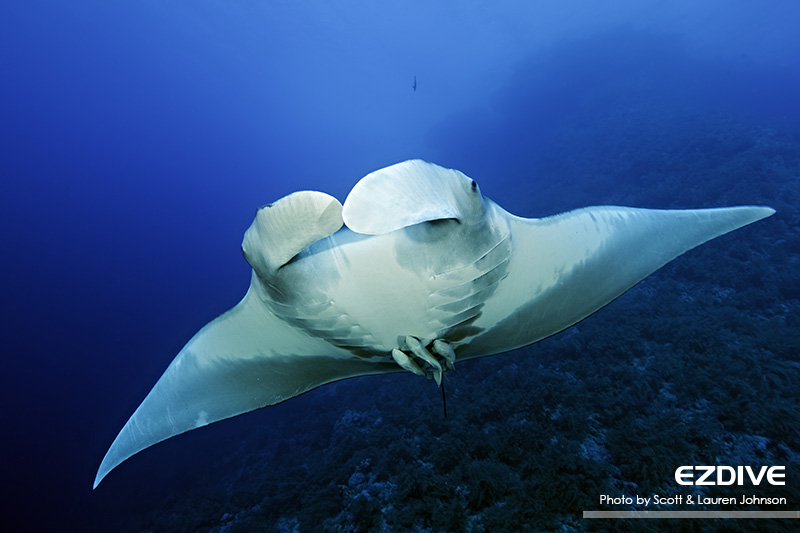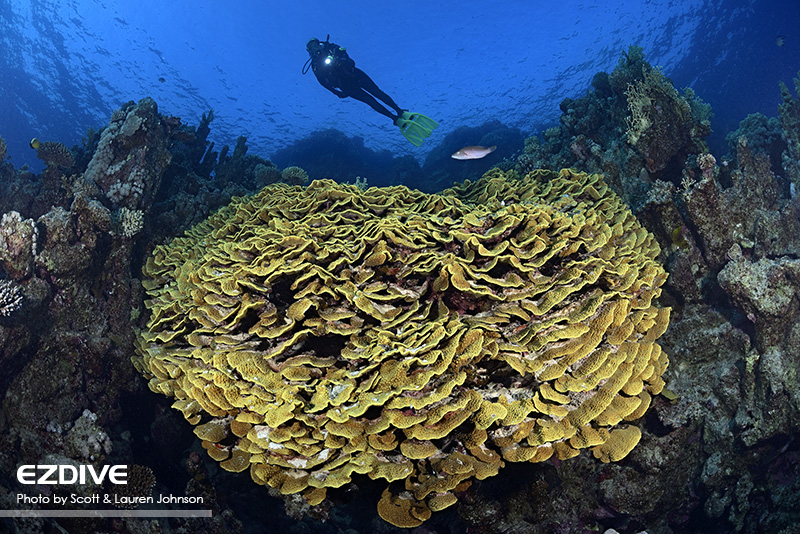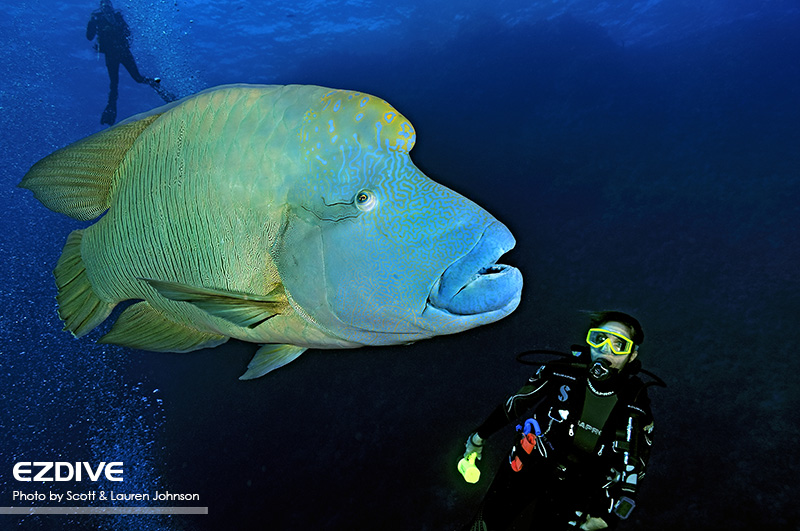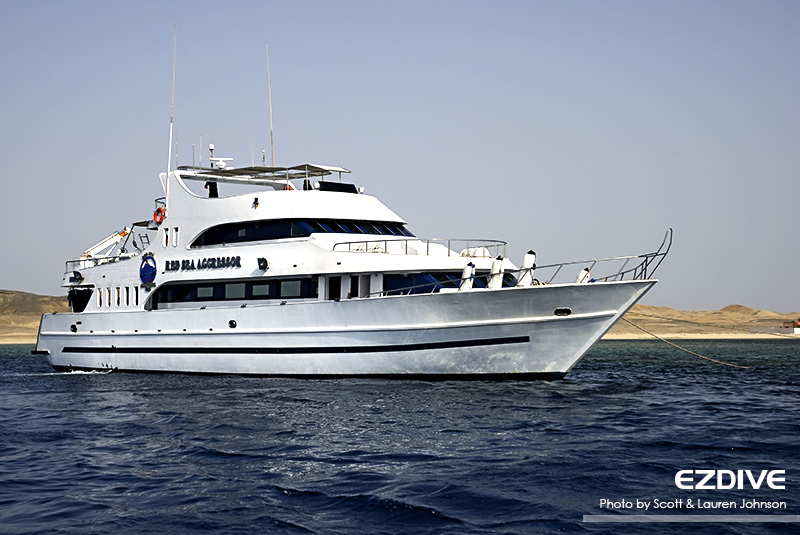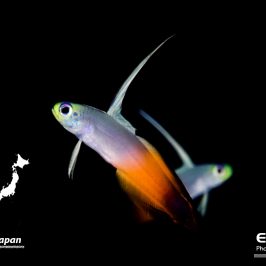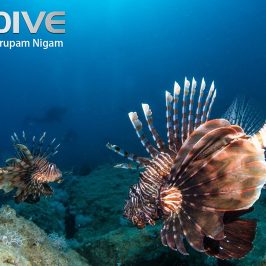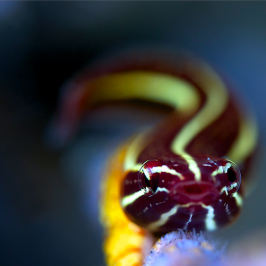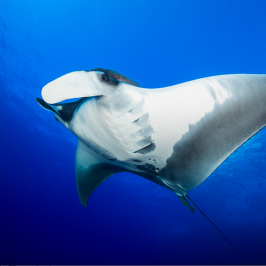A visit to Egypt is both an opportunity to glimpse a true cradle of civilization and sample the bountiful underwater treasures lauded by Dr. Eugenie Clark, Dr. Hans Hass and Jacque Cousteau.
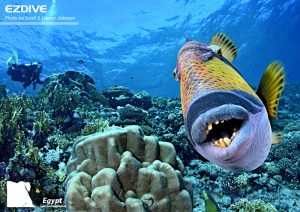
Text and Photo by Scott & Lauren Johnson
The peak of the Great Pyramid of Giza alternately appears and disappears over the crest of the sand dune as my surly camel lumbers toward the only remaining intact member of the Seven Wonders of the Ancient World. Riding atop this ship of the desert, I have traveled a short distance from a sprawling city struggling with 21st century advancements to the iconic sentinels of pharaonic Egypt that still stand on the Giza Necropolis. The striking contrasts between modern day Egypt and the impressive remnants from an age long past are mirrored throughout the country and along the Red Sea, where five star resorts line port cities while natural monuments in the form of prodigious coral reefs host vast communities of marine life.
Oasis of Life
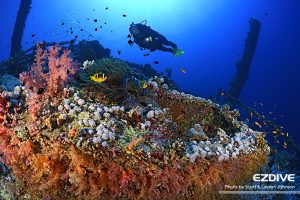 The Arab Republic of Egypt is predominately located in Northeast Africa, but it is also a transcontinental country in that it spans Africa and Southwest Asia via the Sinai Peninsula land bridge. And, it possesses the Suez Canal, the only conduit between the Mediterranean Sea and the Indian Ocean. Egypt is bordered by the Mediterranean Sea to the north, the Gaza Strip and Israel to the northeast, the Gulf of Aqaba and Red Sea to the east, Sudan to the south and Libya to the west.
The Arab Republic of Egypt is predominately located in Northeast Africa, but it is also a transcontinental country in that it spans Africa and Southwest Asia via the Sinai Peninsula land bridge. And, it possesses the Suez Canal, the only conduit between the Mediterranean Sea and the Indian Ocean. Egypt is bordered by the Mediterranean Sea to the north, the Gaza Strip and Israel to the northeast, the Gulf of Aqaba and Red Sea to the east, Sudan to the south and Libya to the west.
Since vast inhospitable deserts dominate the landscape, 99% of Egyptians flock along the Nile River to the live in either the Nile Valley (south) or Nile Delta (north), which together account for only 5.5% of the total available area. In fact, if it were not for the world’s longest river and the extensive oasis it provides, the interior of Egypt would simply be an uninhabitable sea of sand.
Salem Express
The Red Sea is nature’s wreck diving museum, from the World War II era Thistlegorm, a British army supply ship that sank in 1941 off the west coast of the Sinai Peninsula, to the Numidia, a British cargo ship that foundered on Big 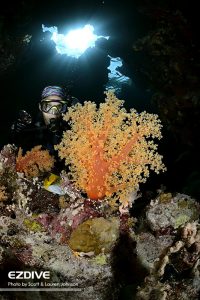 Brother Island in 1901. Of all the wrecks we visit, none impact us more than the Salem Express. This 100-meter passenger ferry carrying over 600 pilgrims returning from Mecca struck the Hyndeman Reef near midnight on December 15, 1991 and sank within 20 minutes. 180 people survived by making their own way to shore. The official death toll of 470 hallmarks this as the worst Egyptian maritime tragedy.
Brother Island in 1901. Of all the wrecks we visit, none impact us more than the Salem Express. This 100-meter passenger ferry carrying over 600 pilgrims returning from Mecca struck the Hyndeman Reef near midnight on December 15, 1991 and sank within 20 minutes. 180 people survived by making their own way to shore. The official death toll of 470 hallmarks this as the worst Egyptian maritime tragedy.
The immense wreck lies on her starboard side at 30 meters. None of the lifeboats were deployed that fateful night and some are still prominently displayed. During our initial dive here, I cannot help but think of the drastic contrast between the celebrated tombs of the Pharaohs we visited on land and the unclaimed bodies still buried inside this steel mausoleum. The Salem Express offers plenty of dramatic photographic opportunities, yet I feel the solemnness of working around this watery graveyard.
Titans and Harems at the Brothers
An overnight cruise aboard the Red Sea Aggressor carries us 105 kilometers southeast from Safaga to the Brother Islands or El Akhawein (“Brothers” in Egyptian). These two small, rocky islands, known as Big and Little, are the tops of undersea mountains separated about 1 kilometer and located 67 kilometers east from the Egyptian coast. The Brothers’ isolation and healthy reefs attract large pelagics and support a diverse variety of reef inhabitants.
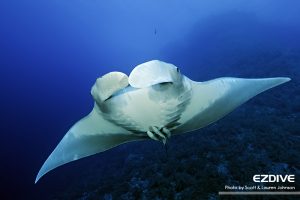 Big Brother sports a Victorian style, brown stone lighthouse that was built by the British in 1883 on its otherwise nondescript surface. The lighthouse did not save the Numidia, but it certainly enhances the pre and post-dive ambiance. We drop up-current of the Numidia and quickly descend lest the stiff current push us past our mark. The wreck lies vertically from 9 meters to the stern at 80 meters, but we go no lower than 34 meters and then work our way progressively more shallow as we take shots of the broken remains. Soft corals festoon the wreck in a neon glow as Lauren sweeps her light over the framework of steel beams that used to support the wooden deck.
Big Brother sports a Victorian style, brown stone lighthouse that was built by the British in 1883 on its otherwise nondescript surface. The lighthouse did not save the Numidia, but it certainly enhances the pre and post-dive ambiance. We drop up-current of the Numidia and quickly descend lest the stiff current push us past our mark. The wreck lies vertically from 9 meters to the stern at 80 meters, but we go no lower than 34 meters and then work our way progressively more shallow as we take shots of the broken remains. Soft corals festoon the wreck in a neon glow as Lauren sweeps her light over the framework of steel beams that used to support the wooden deck.
The highlight of the dive occurs as we are off-gassing in the shallows. Two large titan triggerfish (Balistoides viridescens) appear to alternate between courting and nesting. When one decides to charge us, Lauren makes a quick exit stage right while I stand my ground. The biologist in me is captivated by the titan’s behavior. The photographer is excited by the imaging possibilities. And, the wimp is calculating the damage those glaring buck teeth might inflict on soft tissue. The ensuing dance of the titan mouthing the dome port on my housing and me making sure the dome remains between us while I simultaneously attempt to compose shots ranks as one of the most unusual and exhilarating animal encounters of my career.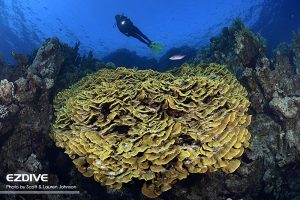
What Little Brother lacks in topside adornments, it makes up for under the water. Over 1,100 species of fish, almost 20% of which are endemic, are found in the Red Sea and most seem to be present here. Brightly colored, neon anthias (various members of Pseudanthias) flitter in thick colonies over the reef. Approach too closely and they magically disappear. Retreat, then wait a moment and they reappear. These gorgeous little fish begin life as females. When a dominant male is lost from the group, one of the biggest females changes sex to take his place. Like the Pharaohs of old, male anthias service harems of up to 40 females.
The Ghost of Daedalus
We push further south to Daedalus Reef during another late night crossing. Daedalus is very similar to Big Brother Island in that it is remote, relatively small (less than a kilometer wide), home to a lighthouse and part of the Egyptian Marine Park system. Sharks, particularly oceanic whitetips and scalloped hammerheads, are often the big draw here. We do spot small schools of six or seven hammerheads in the distance, but a small cloud of golden sweepers spilling out of a small cave at 14 meters grabs our attention.
I carefully make my way inside the cave and behind the nervous fish in order to frame Lauren in a series of poses. Just before we end the shoot, I notice something flutter against the wall to my left. When I lean forward to investigate, I am shocked to find a 16 centimeter ornate ghost pipefish. After showing Lauren the wonderful find, I motion for us to end the dive so I can return to the boat to grab my macro housing. Back aboard the Red Sea Aggressor, our dive guides, Mahmoud and Erin, proclaim they did not even know ornate ghost pipefish inhabited the Red Sea.
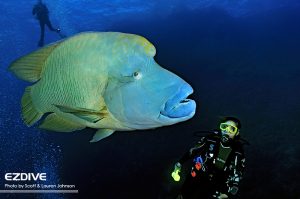
St. John’s Caves
St. John’s Island is located in Foul Bay, near the Sudanese border and within the Elba National Park. The surrounding reef system lies on the Tropic of Cancer and yields one of the most delightful networks of shallow water caves, mazes, swim-throughs and stunning coral and rock formations in existence. Our favorite dive here is at St. John’s Caves (Umm Khararim) where we find exquisite stalks of soft corals in caves positioned as if carefully arranged for an art exhibition. Sunlight streaming through cracks in the shallow cave ceilings dapples soft coral, which makes the coral shine radiantly against the surrounding darkness.
Walk Like an Egyptian
There are an almost infinite number of reasons to visit Egypt and explore the Red Sea aboard the Red Sea Aggressor. The Egyptian land allows you to simultaneously travel back in time to the reign of the Pharaohs and also experience modern day life in an Islamic country. And, the enchanting waters of the Red Sea give you the chance to dive sites reputed to be among the best in the world. To explore one and not the other is somewhat like a snorkeler who never dons a tank to bask in the beauty and mysteries that lie beneath the surface. Besides, it seems a little silly not to learn how to both walk and swim like an Egyptian when you get the chance.
Travel Info
Getting There
The Red Sea Aggressor operates from the Port Ghalib yacht marina near Marsa Alam. The Red Sea Aggressor II embarks/disembarks from Hurghada. International flights typically access the Cairo International Airport. From there, travelers can utilize domestic flights via Egypt Airlines or caravans in order to reach port cities along the Red Sea.
Visa
Visas are valid for only 30 days from date of issue and cost $25 US per person. The departure tax is $25 U.S. per person for international flghts.
Language
Arabic, though English is widely spoken in tourist areas.
Currency
1 USD equals approximately 17.7 Egyptian pound (EGP).
Electricity
220-240 Volts with European style outlets.
Liveaboard
The Red Sea Aggressor and Red Sea Aggressor II of the Aggressor Fleet -www.aggressor.com
